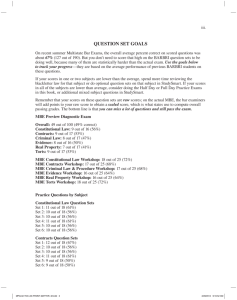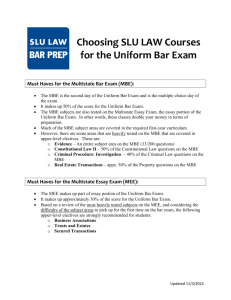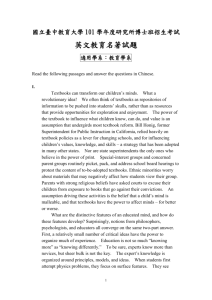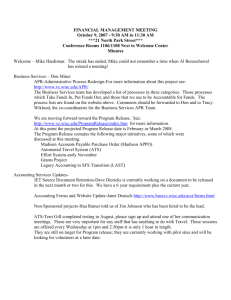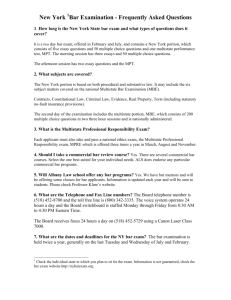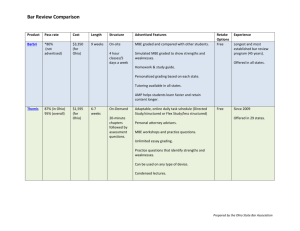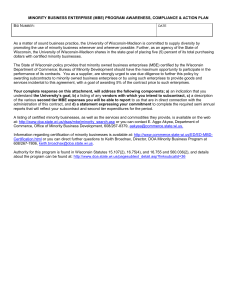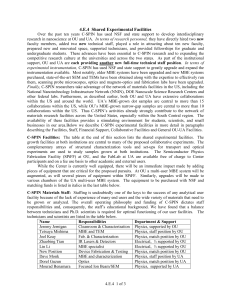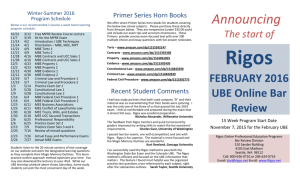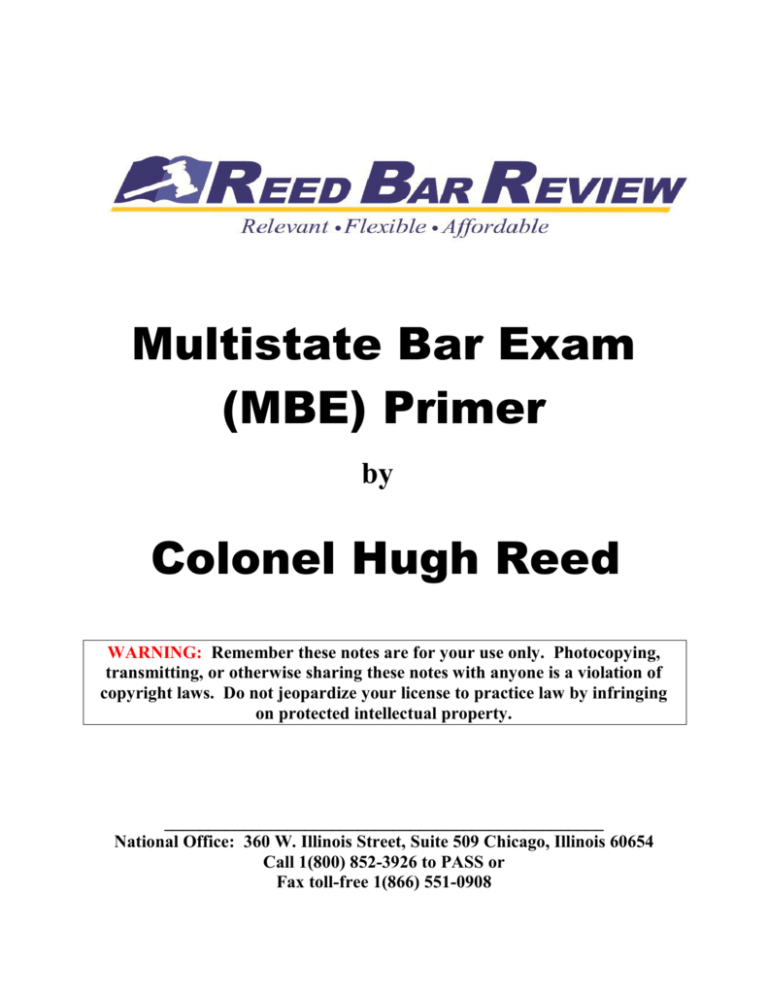
Multistate Bar Exam
(MBE) Primer
by
Colonel Hugh Reed
WARNING: Remember these notes are for your use only. Photocopying,
transmitting, or otherwise sharing these notes with anyone is a violation of
copyright laws. Do not jeopardize your license to practice law by infringing
on protected intellectual property.
__________________________________________________
National Office: 360 W. Illinois Street, Suite 509 Chicago, Illinois 60654
Call 1(800) 852-3926 to PASS or
Fax toll-free 1(866) 551-0908
Colonel Hugh Reed
National Director and Founder of Reed Law Group
"You cannot hope to accomplish on the bar exam what you haven't
practiced in your bar review. Interactive learning, continuous
performance execution, and constant coaching by experts who regularly
take bar exams are invaluable to your success -- listening to long
lectures by those who do not take bar exams regularly, taking copious
notes, and reading long outlines are not."
Hugh Reed
Colonel Hugh Reed (and the attorney-coaches of Reed Bar Review) brings a wealth of experience to help
students succeed on their law examinations. Reed is considered a national expert on examination testing techniques.
He has personally taken and passed almost thirty Multistate Bar Exams (MBEs)...and counting.
With over thirty years of experience in preparing students for their law school and bar examinations, Reed has
developed helpful mnemonics, checklists, and disciplined approaches to help law students and bar candidates succeed
on law examinations. His performance-based approach focuses on remembering key principles of law under the pressure
of timed examination formats. Reed, a graduate of the George Mason University School of Law, is the former
Director of Multistate Testing, Editor-in-Chief, and Director of various states' bar reviews for the largest
traditional bar review in the country; he also has written and edited numerous books and outlines including
Gilbert Law Summaries and Legalines. Professor Reed is admitted to practice before the U.S. Supreme Court, U.S.
Court of Military Appeals, U.S. Tax Court, and numerous states by taking bar exams regularly for his multi-jurisdictional
law practice representing military personnel worldwide. The MBE and the Multistate Professional Responsibility Exam
(MPRE) change constantly-- up to 60 of the 200 questions on the MBE are repeat questions from past exams as are
approximately 15 of the 50 graded questions on the MPRE, for statistical equating purposes—Reed teaches you
how to beat the test. Albeit we are bound legally and ethically not to republish secure questions, Reed Bar Review
constantly monitors changes on the bar exam and is licensed by the National Conference of Bar Examiners to republish
all released questions. We’re committed to train you on the most often tested concepts in order for you to pass your
exam!
Professor Reed, a retired Army Colonel, is also a former Army Airborne Ranger with combat experience
and the Commander of two Army Aviation Brigades, including the U.S. Army's Aviation Training Brigade. He uses
his experience as an Army Ranger and teaching pilots to define his teaching approach for law exams. By using the
principle "practice makes perfect," and flawless performance under anxiety conditions, Reed teaches preparation for law
examinations like Army Rangers rehearse combat missions and pilots learn emergency flight procedures. Reed
programs simulate anxiety-prone conditions, like law examinations, by using interactive reviews that emphasize
memorization and performance techniques utilizing proprietary checklists, mnemonics/acrostics, and other test
preparation devices. These simulated pressure-filled testing conditions and continuous expert feedback have made the
difference between success and failure for countless students, many of whom are now successful attorneys, judges, and
members of Congress. See our website at www.ReedBarReview.com in order to view some of our past students’
testimonials.
Candidates who use our tutoring services for their first attempt to pass their bar exam enjoy the highest
pass rate in the nation! Repeat students, on average, increase their scores by 30-50 points after failing their first
bar exam preparing with traditional bar reviews. Some increased their scores by over 100 points! All U.S. Armed
Forces veterans receive a substantial discount on all services offered.
If you need answers to important questions regarding any aspect of the Multistate Bar Exam (MBE), the Multistate
Professional Responsibility Exam (MPRE), the Multistate Performance Test (MPT), Essay Writing, or tutoring while in law
school, it’s time for you to call us at 1.800-852-3926 today! We will help you map out a strategy for success!
MULTISTATE BAR EXAM PRIMER
TABLE OF CONTENTS
THE MULTISTATE BAR EXAM (MBE) PRIMER
3
In General
3
How the Primer is Organized
3
THE MULTISTATE BAR EXAM ( MBE) and FAQs
4
Introduction
4
Description of the MBE
4
FAQs About the MBE
5
MYTHS AND FACTS ABOUT THE MBE
8
RECENT CHANGES TO THE MBE
11
HOW TO ATTACK THE MBE
13
Various Categories/Forms of Questions Dictate Your Attack
13
Your Approach to Attack Multistate Questions
13
Multistate Exam Timing
14
Timing Yourself
14
How to Pick Between Two Answer Choices
15
Using Explanatory Answers to Learn Law and Application
15
Diagnostic Testing
15
Scoring Your Performance
15
Example of How to Report Questions Missed
16
GENERAL TESTMANSHIP TIPS
17
Read Carefully
17
Focus on the Call of the Question
17
Never Look for the Right Answer But Eliminate Worse Answer Choices
17
Test Each Answer Choice Factually, Legally, and Application Accuracy
17
When in Doubt, Stick to Basics and Majority Rules
18
Beware of Terms of Art, Strange Facts, Statutes, and Quotation Marks
18
Do Not Become Emotionally Involved
18
Always Know What Sub-Topic is Being Tested and Answer Accordingly
19
Keep Moving at a Steady Pace and Observe Time Management
19
Keep the Status Quo
19
A Final Word of Advice from Hugh Reed
19
(This page has been intentionally left blank)
Reed Bar Review
The Bar Exam Experts.
All Rights Reserved.
2
THE MULTISTATE BAR EXAM (MBE) PRIMER
IN GENERAL
The Multistate Bar Exam (MBE) can have a dramatic impact on your overall bar exam
performance. In most states, this score will be determinative whether you’ll pass or fail your bar
exam. Given that the MBE is a secure and confidential exam and that Reed Multistate Bar
Review’s attorney/coaches regularly take the MBE, you will have the benefit of what is tested on
the most recent MBEs and will be able to study with the most current questions, both actual
released questions and simulated questions prepared by our faculty. Reed Bar Review is licensed
by the National Conference of Bar Examiners (NCBE) -- the proponent of this exam -- to
republish actual released bar exam questions and answers. Indeed, the Director of Testing for
the NCBE has noted that the MBE will decide your overall score in most states! In this section,
we will discuss how to proceed with your multistate studies for maximum benefit.
As a preliminary matter, it is important to know what this primer will do for you and what it will
not do for you. Your review for the MBE should ensure you have two skills: a good grasp of the
substantive law and the ability to analyze MBE questions from a testing perspective. This primer
addresses only the second function -- analysis. Substantive review, on the other hand, is the task
of learning all the law you need to know in order to pass the MBE. Many students are tempted to
learn the law by practicing on thousands and thousands of simulated MBE questions. Answering
MBE questions, even actual ones from past exams like the ones in this primer, cannot make up
for poor substantive review. While answering MBE questions will remind you of many of the
principles you need to know, it's necessarily a “scattershot” process and this makes it a lessthan-effective way to review the law. A systematic approach will be covered, infra.
The most effective way to review the substantive law you need for the MBE is to review material
to the level of detail you need in an organized fashion. Reed’s approach is an easy and effective
way to review most, if not all, the details you need to know for the MBE.
HOW THE PRIMER IS ORGANIZED
There are five major sections in this primer: 1) The current makeup of the MBE and FAQs;
2) Myths and Facts About the MBE; 3) Recent Changes to the MBE; 4) “How to Attack the
MBE,” and 5) General Examsmanship Guidelines. Several mini-exams and full-length practice
exams are available for enrollees to our program to test you by subject/sub-topics and/or all
subjects combined.
Reed Bar Review
The Bar Exam Experts.
All Rights Reserved.
3
THE MULTISTATE BAR EXAM (MBE) and FAQs
INTRODUCTION
The Multistate Bar Examination (MBE) is a six-hour, two-hundred question multiple-choice
examination covering contracts, torts, constitutional law, criminal law, evidence, and real
property.
The Multistate Bar Examination (MBE) is developed by the National Conference of Bar
Examiners (NCBE) and is administered by participating jurisdictions on the last Wednesday in
February and the last Wednesday in July of each year. Applicants should contact the jurisdiction
where admission is being sought to ascertain whether the MBE is part of the jurisdiction's
examination. For an updated list of contact information for various jurisdictions, see ncbex.org.
The MBE is but one of a number of measures that a board of bar examiners may use in
determining competence to practice – however, it is the most important in almost all states.
Each jurisdiction determines its own policy with regard to the relative weight given to the MBE
and other scores. Questions about the use made of MBE scores should be directed to the
appropriate jurisdiction, not to NCBE.
DESCRIPTION OF THE MBE
The Multistate Bar Examination is an objective six-hour examination containing 200 questions.
The examination is divided into two periods of three hours each, one in the morning and one in
the afternoon, with 100 questions in each period. The examination includes 190 “live” test
questions in the following areas: Civil Procedure, Constitutional Law, Contracts, Criminal Law
and Procedure, Evidence, Real Property, and Torts. There are 28 questions tested in Contracts and
27 questions tested in Civil Procedure, Constitutional Law, Criminal Law and Procedure,
Evidence, Real Property, and Torts, respectively. Included in the exam are 10 pretest questions
which are indistinguishable from the live test items, but will not be used for scoring purposes.
The questions on the examination are designed to be answered by applying fundamental legal
principles rather than local case or statutory law. A given question may indicate the applicable
statute, theory of liability, or comparable principle of law.
Many of the questions require applicants to analyze the legal relationships arising from a fact
situation or to take a position as an advocate. Some questions call for suggestions about
interpreting, drafting, or counseling that might lead to more effective structuring of a transaction.
All questions are multiple-choice. Applicants are asked to choose the best answer from the four
stated alternatives. The test is designed to give credit only when the applicant has selected the
best answer. Therefore, applicants should mark only one answer for each question; multiple
answers will not be counted. Also, for each subject, it is important to note how many questions
are tested in respective sub-topics, e.g., 50% of all questions tested in Crimes are Criminal
Procedure. (Refer to http://www.ncbex.org/assets/media_files/MBE/MBE-Subject-MatterOutline.pdf for a description of each subject and sub-topic.)
Scores are based on the number of questions answered correctly. Applicants are, therefore,
advised to answer every question. Time should be used effectively. Applicants should not hurry,
but should work steadily and as quickly as possible without sacrificing accuracy. If a question
Reed Bar Review
The Bar Exam Experts.
All Rights Reserved.
4
seems too difficult, the applicant is advised to go on to the next one and come back to the skipped
question later.
Answer sheets are centrally scored. Both raw scores and scaled scores are computed for each
applicant. A raw score is the number of questions answered correctly. Raw scores on different
forms of the test are not comparable primarily due to differences in the difficulty of the test
forms. A statistical process called equating adjusts for variations in the difficulty of different
forms of the examination so that any particular scaled score will represent the same level of
performance from test to test.
For instance, if a test were more difficult than previous tests, then the scaled scores on that test
would be adjusted upward to account for this difference. The purpose of these adjustments is to
help ensure that no applicant is unfairly penalized (or rewarded) for taking a more (or less)
difficult form of the test.
FAQs ABOUT THE MBE
If you are like most students, there is quite a bit about the Multistate Bar Exam you do not know.
Here are the answers to some of the questions we hear most frequently.
Is the MBE required in every state?
Almost. Only one state does not administer the MBE: Louisiana.
Apart from Louisiana, if you are taking the Bar Exam in the Virgin Islands, the Trust Territories,
or Guam, you will also take the MBE. Puerto Rico does not use the MBE.
What date is the MBE given?
The MBE occurs on the last Wednesday in February and the last Wednesday in July of each year.
The "state" portion of the exam is typically essays on a variety of subjects. It generally takes
place on the day immediately after the MBE. In some jurisdictions, however, the MBE precedes
the essay part, e.g. Virgin Islands, Texas, etc.
What is the format of the MBE?
It is a six-hour examination containing 200 questions. There are two periods of three hours each,
one in the morning and one in the afternoon, with 100 questions in each period.
What subjects are covered on the Multistate Bar Exam?
There are seven major subjects on the MBE: Civil Procedure, Constitutional Law, Contracts
(including Sales), Criminal Law (including Criminal Procedure), Evidence, Real Property
(including Future Interests), and Torts.
How many questions are there on each subject?
Currently, there are 27 questions tested in each subject except for Contracts; the latter has 28
questions. (The 10 experimental questions that are not graded, can come from any subject.)
Reed Bar Review
The Bar Exam Experts.
All Rights Reserved.
5
What is the format of MBE questions?
The MBE is an "objective" multiple-choice, exam. Each question has four potential answer
options, with one correct answer and three incorrect answers, called "distractors." In the past up
to 60 questions are repeat questions from past exams for statistical equating purposes.
What order are the questions in?
They are completely random, as to both subject matter and difficulty. Thus, you may have a very
difficult Property question followed by a simple Contracts question. The subject matter of the
question is not given; this is something you must deduce from the question itself.
The randomness of difficulty distinguishes the MBE from other standardized tests you have
taken, like the SAT, in which the questions become progressively more difficult within each
section of the test. Your testing will be on approximately one-half of the questions in each subject
in the morning exam and the other one-half in the afternoon.
Are all the questions on the MBE given the same weight?
Yes. Difficult questions are worth no more than easy ones.
How is the MBE graded?
Each question is worth one point, making a total possible "raw" score of 190. Because the
difficulty of the MBE may vary from test to test, "raw" scores are not comparable. Thus, a
statistical procedure called "equating" produces "scaled" scores, so the performance of Bar
Examinees can be compared (within the limitations of measurement and equating error). For
instance, if a particular test is more difficult than previous test forms, the scaled score would be
adjusted upward to account for this difference. If a test is easier than previous test forms, then the
scaled score would be adjusted downward to account for this difference. This ensures fair
treatment of applicants.
Keep in mind you will not receive credit for any answer other than the best one. In addition, if
you fill in more than one answer to a question, you will get no credit for it.
Will I lose points for wrong answers?
No, the MBE is not like the GMAT. Wrong answers are not penalized.
Are the official answers to the MBE ever wrong?
The answer to this has to be a qualified "yes".
Even though the MBE is carefully prepared, some questions are not completely correct. In order
to combat this, a process called "early item analysis" is used. Immediately after each examination,
the bar examiners score and analyze 1,500 or so applicants in three or four jurisdictions. If a large
number of applicants scoring highest on the entire exam are marking the wrong option in a
particular question, then the correctness of the official answer is suspect. The drafting committee
receives any suspect question and if not correct, a change in the key occurs. In addition, if the
entire question is faulty, applicants receive credit for any one of the four answer options. More
often, however, applicants receive credit for two of the four options, when two options are clearly
Reed Bar Review
The Bar Exam Experts.
All Rights Reserved.
6
wrong and it proves too difficult to select between the two remaining options. After this "early
item analysis," the new key will score all answer sheets.
If you enter the MBE anticipating some of the questions may be unanswerable, you may
prematurely bail out of a few questions and choose the wrong answer, figuring the question is
wrong and that you will get credit even for a wrong answer. This is a mistake since the question
may simply be difficult and with a little analysis, you would get the right answer. Moreover, the
drafters simply do not make many mistakes -- certainly no more than a handful on each exam.
What score do I need to pass?
Since the bar examiners of each jurisdiction use the MBE in different ways, the answer to this
depends on where you are taking the exam. In some states, with a sufficiently high score on the
MBE, the bar examiners won't even look at your essays (the theory behind this is that, if you did
very well on the MBE, you are likely do the same on the essay, so there is no need to grade the
essay as well). As noted, supra, in most states, the MBE is determinative of passing or failing.
Most states combine MBE and essay scores to determine a passing score. There are three
formulas for combining the two scores: the standard deviation method, the comparative range
method or the equi-percentile method. All three are quite involved and are beyond the scope of
this primer.
Who writes MBE questions?
As you might imagine, drafting MBE questions is an involved process requiring many people.
Five-person committees (three law professors and two bar examiners) draft questions. Each
committee then meets for two days with testing experts to redraft questions. Thirty or forty
questions are prepared at each semiannual meeting. After the meeting, each committee member
reviews the questions as redrafted and then reviews them again a few weeks later when they are
in final form. There is also a review of the questions in the final process by a practicing attorney
and usually by a law professor who is not a member of the drafting committee.
Since the MBE is a part of each jurisdiction's bar examination, the bar examiners of each
participating jurisdiction are given an opportunity to review the test in its final stages. At that
time, the test can be accepted or rejected. Reviews by local bar examiners may also result in
suggestions for changing some of the questions. Each drafting committee considers these
suggestions and changes are made if the drafting committee so decides.
Reed Bar Review
The Bar Exam Experts.
All Rights Reserved.
7
MYTHS AND FACTS ABOUT THE MBE
(According to the NCBE)
Bar Examiners across the country often encounter questions and myths relating to the Multistate
Bar Examination (MBE), one of the important parts of their test of minimum competence for
licensure to practice law. Over the years, significant research has been conducted that dispels
these myths.
Myth 1
Examinees can pass the MBE by guessing. The MBE is a test of memory and test-taking ability,
not of legal knowledge or analytical skill.
Fact
Research indicates that the MBE is not a “multiple-guess test” or an examination that rewards
test-taking ability. In research conducted in July 1986, incoming law students took the morning
session of the MBE, and their scores were compared to graduates of the same law schools who
had taken the same examination. The novices and graduates had virtually identical mean LSAT
scores, so if the ability to take multiple-choice tests were the major factor influencing MBE
scores, both groups should have had very similar MBE scores. In fact, the highest MBE score
earned by the novices was lower than the lowest score earned by any of the graduates.
Second, research on the MBE indicates that MBE scores are highly correlated with other
measures of legal skills and knowledge, such as scores on state essay examinations and law
school grades. These correlations provide empirical evidence that the MBE is testing legal ability
rather than general test-taking ability. Similarly, a panel of experts convened in 1992 as part of a
content validity study and concluded that MBE items were material to the practice of law and that
their emphasis was balanced between legal reasoning skills and memorization of legal principles.
Myth 2
MBE questions are needlessly difficult, arcane, and tricky.
Fact
MBE questions are designed to be a fair index of whether an applicant has the ability to practice
law. MBE questions are written by drafting committees composed of men and women who are
law teachers and practitioners. Before it is administered, every MBE question is reviewed at
several levels: at least twice as it is edited by the drafting committee; by psychometric experts to
insure that it is fair and unbiased; by the practitioner members of the MBE Policy Committee and
their academic consultants; and by the members of boards of bar examiners across the country.
After a form of the MBE is administered, any question that performs in an unanticipated
manner—is very difficult or is missed by applicants who did well on the rest of the test—is
flagged by psychometric experts and reviewed again by content experts on the drafting
committees to ensure that no ambiguity exists in the question and that the key is unequivocally
correct. Should an error be detected even after this thorough scrutiny, two or more answers may
be deemed correct in order to ensure that no applicant is disadvantaged by having a particular
question appear on the form of the MBE he or she took.
In a 1992 study, expert panelists reported that they believed MBE items were generally easy,
correctly estimating that about 66 percent of candidates would select the right answer to a typical
Reed Bar Review
The Bar Exam Experts.
All Rights Reserved.
8
item. A study is underway to review the MBE test specifications (subject matter outlines) in order
to make certain that the questions asked on the examination continue to relate to knowledge that
is important to the practice of law.
Myth 3
Not enough time is allotted to answer MBE questions.
Fact
Research shows that the time allotted to take the MBE is sufficient for 99 percent of applicants.
The MBE is designed to be answered by a reasonably competent applicant in the amount of time
available. The rate of correct responses at the end of three-hour sessions is not significantly
different than the rate of correct answers at other, earlier points in the test.
A research project in which applicants were given virtually unlimited time to answer the MBE
resulted in an average increase in score of about 6 raw (unscaled) points. Since all groups benefit
from an increase in time to the same degree, and since the test is scaled to account for differences
in difficulty, an increase in average score would be offset in the scaling process and additional
time would not increase applicants' scaled scores.
Myth 4
Essay examinations and performance tests are a better way to measure minimum competency to
practice law.
Fact
While essay examinations and performance tests provide important information about candidates,
there are several significant advantages to including multiple-choice tests on a bar examination.
First, multiple-choice testing offers the opportunity for a breadth of coverage of subject areas
which cannot be duplicated using only essay questions or performance tests. This breadth of
coverage improves the reliability of the examination. Second, multiple-choice questions can be
scored objectively, and scores can be scaled to adjust for changes in difficulty from one test to the
next. There are two sources of variation in difficulty in essay examinations and performance tests:
variations in the difficulty of the test items themselves, and variations in how strict or lenient
graders are. In contrast, scores on the MBE are equated through a process that ensures that a new
form of the MBE is no more nor less difficult than a previous form. By comparing the
performance of applicants on a common set of items, raw scores on the test can be converted to
adjusted, “scaled” scores that are directly comparable to one another. Because scores are equated,
the MBE provides an anchor for other, more subjective test scores; the National Conference
recommends that scores on essay examinations and performance tests be scaled to the MBE. And
finally, this scaling of MBE scores allows direct comparisons of performance to be made among
tests. An applicant taking a current examination is on a level playing field with other applicants
taking tests at other times.
Reed Bar Review
The Bar Exam Experts.
All Rights Reserved.
9
Myth 5
The MBE discriminates against minority applicants.
Fact
The MBE neither widens nor narrows the gap in performance level between minority and
majority applicants. Research indicates that differences in mean scores among racial and ethnic
groups correspond closely to differences in those groups' mean LSAT scores, law school gradepoint averages, and scores on other measures of ability to practice law, such as bar examination
essay scores or performance test scores. Individual items on the MBE that are relatively difficult
for one group are relatively difficult for all groups; the relative difficulty of the items within a
subtest (e.g., the Constitutional Law items versus the Torts items) does not differ from group to
group. Finally, total MBE scores are not higher or lower from group to group than they are on
other test formats.
All items on the MBE are reviewed for potential bias. Men and women serve on each drafting
committee, and members of ethnic minority groups assist in the preparation and review of items
at both the drafting committee level and at the level of MBE Committee and state Board review.
The National Conference of Bar Examiners is committed to diverse representation on all its
drafting and policy committees.
Myth 6
The MBE is getting easier; scores keep increasing while applicants are getting less able.
Fact
The MBE is a reliable measure of applicant ability. The average scaled score on the MBE has
varied by less than 2 points from year to year, indicating that the ability level of the candidate
pool has been fairly stable. Changes in MBE scores follow closely the variations in average
scores on other measures of candidate ability, such as the LSAT. This correlation between
changes in MBE and LSAT scores indicates that increases in the average score mirror increases
in the general ability level of the group being tested rather than a decline in the difficulty of the
test.
Reed Bar Review
The Bar Exam Experts.
All Rights Reserved.
10
RECENT CHANGES TO THE MBE
PRETESTING
For psychometric purposes, the addition of pretesting--using items on an examination that are
being "tried out" but do not count in the examinees' scores--to the MPRE (in 2005) and the MBE
(in 2007) has been an enormous milestone. The pretesting process established 10 unscored
question slots on both the MPRE, which moved from 50 questions to 60 questions to
accommodate the pretest additions, and the MBE, which remained at 200 questions overall by
having the number of scored questions reduced from 200 to 190. Because each of these
examinations is administered with eight different forms each time, multiplying the 10 available
pretest question slots on each form by the eight forms results in 80 questions being tested on a
trial basis during every administration.
The significance of pretesting is hard to overstate. It allows NCBE's drafting committees to
rework questions that do not perform as expected, making them harder or easier, or eliminating
subtle ambiguities that may have gone unnoticed during the drafting and editing processes. When
questions that have been pretested are placed on exams as scored questions, there is greater
assurance that they will function as intended (by discriminating between highly knowledgeable
applicants and less knowledgeable applicants). With the limited amount of testing time, each
question on the examination should shoulder some of this discriminatory burden, and the
pretesting process has gone a long way toward ensuring that result.
PRE-EDITING
All multiple-choice questions that appear on NCBE exams are drafted by individual experts and
then reviewed multiple times by committees of content experts. Beginning with the MPRE
drafters in 2005, multiple-choice-question drafters have been adopting NCBE's pre-editing
process in which newly drafted questions are edited and proofed at NCBE, and then reviewed and
approved again by the drafters before being reviewed for the first time by the full committees.
Through this process, which has received high praise from the drafters, questions are more
focused at their first committee review, making the reviewing process more efficient. From a
program-wide perspective, questions have also become more consistent in style and format,
making for a cleaner end product. Specifically, multiple-choice questions which are divided into
the fact pattern setting up the problem, or the "stem," (the question at the end of the stem, known
as the "lead-in,") and the choices available to the examinee for answering the question, or the
"options", are regularly reframed in the preediting process to adhere to the following conventions
(supported by psychometric research):
• Questions should be concise. Fact patterns and options should be reduced in length wherever
practicable without decreasing the difficulty or complexity of the legal issues being tested.
• Questions should never be presented in the “K-type” format (using Roman numerals in
complex options, e.g., I is true, but II and III are not true).
Reed Bar Review
The Bar Exam Experts.
All Rights Reserved.
11
• Common nouns should be used in lieu of proper nouns wherever practicable. For example,
"a painter" might encounter a contract problem rather than “Pat," "Alpha," or "Painter."
• All of the facts necessary to answer the question should appear in the fact pattern. The
appearance of hypothetical facts in the options of multiple-choice questions (typically introduced
by the words "if" or "unless") has been significantly reduced since 2005. The use of formatting
that places different facts in each option, asking the applicant to choose the set of facts that meets
a particular standard, has also declined.
• Quotes should be avoided unless necessary to the legal issue being tested – e.g., quoting a
statute may be required in an interpretation question or quoting language might be necessary in a
contract question.
• Language in the options should be parallel. To the extent possible, options should demand
that the applicant compare and choose between similar elements-e.g., the four options might
layout four different causes of action, four different defense theories, etc.
• No option should be the equivalent of “None of the above" or “All of the above.” Questions
should be answered adequately by a single option without speculation.
• Examination questions should cover a variety of tasks. Drafters are encouraged to write
questions covering a range of skills and tasks, g., the ability to gather information, the ability to
spot dispositive issues, the ability to synthesize the law with the facts, etc.
• Starting with the February 2015 MBE, Civil Procedure has been added to the exam.
NOTE: According to the President of the NCBE at a recent Bar Passage meeting sponsored by
the ABA, the MBE still uses questions from past MBEs for statistical grading purposes.
Therefore, it is to your advantage to study with questions that are reflective of what has been
tested.
Reed Bar Review
The Bar Exam Experts.
All Rights Reserved.
12
HOW TO ATTACK THE MBE
The exam is divided into two periods of three hours each, one in the morning and one in the
afternoon with 100 questions in each period. The exam is graded from the following subjects:
Constitutional Law
Criminal Law
Real Property
Civil Procedure
27 questions
27 questions
27 questions
27 questions
Contracts
Evidence
Torts
28 questions
27 questions
27 questions
VARIOUS CATEGORIES/FORMS OF QUESTIONS DICTATE YOUR ATTACK
a) Best of the Lot -- asks you to pick the best of sometimes four bad alternatives. NEVER
LOOK FOR THE RIGHT ANSWER! Always look for the best of sometimes four bad answers.
b) Worst of the Lot – asks you to pick the worst or least likely answer choice. ASK
YOURSELF, WHAT IS A GOOD ANSWER AND PUT A + SIGN NEXT TO IT. This should
result in three + signs and one – sign.
c) Dichotomy – two answer choices hold one way and two hold another with varying reasons.
RE-READ THE CALL OF THE QUESTION, SELECT WHICH SIDE WILL DICTATE THE
OUTCOME AND SELECT FROM TWO ANSWER CHOICES THAT FAVOR THE
OUTCOME.
d) True/False – these tier-type questions will ask you to select a combination of several romannumeraled selections. PUT A + OR – SIGN NEXT TO EACH PROPOSITION AND SELECT
THE CLOSEST COMBINATION OF CHOICES.
e) Case Squib – will ask you to match fact patterns to case summaries, most-often tested in
Criminal Law. ANALYZE EACH CASE BY 1) TOPIC; 2) OUTCOME; AND 3) DECIDING
FACTOR.
YOUR APPROACH TO ATTACK MULTISTATE QUESTIONS
STEP 1 -- Skim over answer choices to see what subject you're in.
STEP 2 -- Read the call of the question—the interrogatory-- to see what examiners want.
(Accept implausible conclusions.)
STEP 3 -- Read the facts. Pay special attention to statutes, quotes, and facts dictated by the call.
STEP 4 -- Reread the call; confirm question; restate if necessary.
STEP 5 -- Analyze the picks. Your analysis of the picks will vary depending on the subject
matter and the form of the question. Cross through incorrect picks. Answer by process of
elimination.
Reed Bar Review
The Bar Exam Experts.
All Rights Reserved.
13
STEP 6 -- Identify the correct pick. Double check your answer by identifying the incorrect
picks.
STEP 7 -- If you do not know the answer make an educated guess. (Return to the question after
you have completed the remainder of the questions -- quite possibly some other information in
other questions will have jogged your memory or will have given you an additional clue.) Stay
positive.
STEP 8 -- Immediately put the previous questions out of your mind when completed and move
on!
MULTISTATE EXAM TIMING
Remember you have between 1.7 and 1.8 minutes per question –at a minimum, plan on
completion of approximately 16-17 questions every 30 minutes – DRAW TIME LINES BEFORE
YOU START. (I personally like to complete 17-18 questions every 30 minutes which allows
extra time to return and reconsider questions I marked with a question mark.)
SET YOUR WATCH
TO 12 WHEN STARTING
THE EXAM!
Report to exam site – check instructions
Morning exam begins
Finish questions 16 - 17
Finish questions 33 - 34
Finish questions 50 - 51
Finish questions 67 - 68
Finish questions 84 - 85
Finish question 100
8:30 a.m. 9:00 a.m. 9:30 a.m. 10:00 a.m. 10:30 a.m. 11:00 a.m 11:30 a.m. 12:00 noon -
The questions are evenly distributed between the morning and afternoon session; studying
between sessions is futile and counter-productive.
1:30 p.m.
2:00 p.m.
2:30 p.m.
3:00 p.m.
3:30 p.m.
4:00 p.m.
4:30 p.m.
5:00 p.m.
-
Report to exam site – check instructions
Afternoon exam begins
Finish questions 116 - 117
Finish questions 133 - 134
Finish questions 150 - 151
Finish questions 167 - 168
Finish questions 184 - 185
Finish question 200
TIMING YOURSELF
As you know, the MBE is a timed test. When you actually sit for the MBE, you will have
approximately 1.7 - 1.8 minutes per question as discussed, supra. When you first begin to
practice MBE questions, ignore the time constraints. The important things to learn are the
nuances of the language the Bar Examiners use, the nature of the details they test, and how to
begin to think the way they do. This necessarily requires more than a minute or so per question. If
you follow this advice, and take your time on each question, you'll benefit in the long run. As you
become more proficient at answering MBE questions, your speed will naturally increase.
Reed Bar Review
The Bar Exam Experts.
All Rights Reserved.
14
However, once you actually begin taking timed exams, it is critical that you draw yourself time
lines. E.g., before you begin the exam, draw a line after question 17 or 18 and mark the 30minute mark. After question 35 or 36, mark a 1-hour mark, etc. By using this approach you will
insure that you stay on time and you’ll have time remaining at the end of your 3-hour session to
go back and take a closer look at any questions you marked with a question mark in your test
booklet.. Should you find yourself behind at these milestones, simply fill in the remainder of the
answers on the answer sheet and mark the questions with a question mark in the question booklet.
HOW TO PICK BETWEEN TWO ANSWER CHOICES
1. Always choose statements of law over fact!
2. Choose the longer and more specific answer choice.
3. Choose an answer choice that deals with "first in time" over other answer choices. E.g.
elements of a crime must be considered before we get to the defenses, if any.
4. Stay away from latin terms, language you've never heard of (don't assume you were absent
that day in law school), and absolutes, e.g., “never”, “always”, “only”, etc.
5. Associate legal terms with the subject matter and sub-topic that is being tested. "Guilty" Criminal Law; "Reasonable Person"-- Torts; Res ipsa loquitur – Negligence, etc.
6. Check modifiers “if”, “because” “unless”-- remember, “no, unless” means “if” – choose them
in this order.
TEST TIP: One way to remember how to guess intelligently is with the acrostic Larry Liked
Fried Shrimp Perfectly Cooked: Law over fact; Longer more specific answers; First in time;
Stay away; Play word association; and Check modifiers.
USING EXPLANATORY ANSWERS TO LEARN LAW AND APPLICATION
For every question you miss, you need to read the explanatory answer and why the wrong answer
choices are incorrect. You will find the answers in each subject go far beyond telling you the
basic principle involved in each question. For every incorrect response, you learn the specific
error you made and you will even learn what other principles you might have been thinking of in
picking that response. You will find it is not necessary to read every answer to every question;
you need only read the answer to the response you chose and the correct response (if they differ).
DIAGNOSTIC TESTING
After completing all subjects and practice questions, you will take an actual released MBE. Your
results on this practice MBE plus your past performance on practice questions will be your
roadmap as to what to study before attempting another diagnostic MBE.
SCORING YOUR PERFORMANCE
When you are done with each section, itemize all questions missed in the order of the major
headings tested in each subject categorizing questions missed according to the outline published
by the NCBE found in front of each subject matter mini-review. For example, there are five major
categories of Evidence. You should write Roman I – V on a sheet of paper and report the
questions missed by question number under each Roman number heading that is tested. You
should also write down the correct answer choice and the sub-area of the law the question tested.
BY KEEPING TRACK OF WHERE YOU MISSED QUESTIONS DURING YOUR
PRACTICE SESSIONS, YOU WILL BE ABLE TO FOCUS ON AREAS OF
OPPORTUNITY DURING YOUR NEXT STUDY SESSION.
Reed Bar Review
The Bar Exam Experts.
All Rights Reserved.
15
EXAMPLE OF HOW TO TRACK QUESTIONS MISSED
QUESTIONS MISSED IN EVIDENCE
Missed 8 out of 50 (Intensive Review Questions)
WRONG
CORRECT
SUBTOPIC TESTED
ANSWER
ANSWER
CATEGORY
NAME
CATEGOR
Y
Q#
Presentation
of Evidence
I
8
A
D
Relevancy
and Reasons
for Excluding
Evidence
II
5
A
C
Relevancy
and Reasons
for Excluding
Evidence
II
12
A
B
Privileges and
other policy
exclusions
Privileges and
other policy
exclusions
III
3
B
D
III
21
D
B
Writings,
recordings, and
photographs
IV
18
D
A
Hearsay and
Circumstance
s of its
admissibility
Hearsay and
Circumstance
s of its
admissibility
V
33
D
A
V
30
A
C
Reed Bar Review
The Bar Exam Experts.
All Rights Reserved.
When a witnesses specific instances of conducts are
involved extrinsic evidence is not allowed. However
when presenting intrinsic evidence then witness can
be impeached by intrinsic evidence of unconvinced
bad acts. There are six ways to impeach: Peter
Beat Paul Silly On Saturday: Prior inconsistent
statements; Bias, Prior convictions; Specific bad
acts; Opinion and reputation evidence; and
Sensory deficiencies.
During attorney-client relationship when the “others”
present are those reasonably necessary to the
professional consultation the communication will
still be considered confidential and still subject to the
attorney-client privilege as long as all other
conditions are also met. Remember that
investigators would be considered reasonably
necessary to a professional relationship.
If the cross-examination is not complete then the
direct testimony should be stricken from the record.
The appropriate remedy when cross-examination is
not possible is to strike the direct testimony from the
record.
Extrinsic evidence which only discredits a witness,
without bearing on any substantive issues in the case
is called collateral and is not admissible.
A piece of evidence is legally relevant if its probative
value is not substantially outweighed by the possibly
of unfair prejudice. Exclusion of evidence for
prejudicial value typically involves gruesome photos,
severed limbs and the like.
An expert witness may be cross-examined by
challenging his credentials. Attacking an expert’s
credentials is analogous to attacking a lay witnesses
defects in perception, memory or capacity, since they
both call into question how much weight should be
attached to the witness’s testimony.
A hearsay exclusion party admission is one that is
made by a party opponent. Unlike a statement
against interest under FRE 804, the declarant does
not have to be unavailable.
Admission by silence is only admissible under FRE
801 if the person heard the accusatory statement, he
was capable of denying the statement and a
reasonable person would have denied the statement
were it not true, under the same circumstances.
However a person under the custody of police could
reasonably feel that he didn’t want to say anything.
16
GENERAL TESTMANSHIP TIPS
RULE 1. Read Carefully.
Under the time constraints of the MBE, you will only have time to read a factual setting once, in
detail. Make it count! You have to read carefully in order to answer correctly. Many wrong
answers, or "distractors," are for people who skipped over an important fact. As you read a
question, you may want to highlight important points and read the question actively, i.e.,
underline, draw yourself timelines, circle dates, parties, events, etc.
Do not become lazy, particularly in the afternoon of the exam, and let your mind wander. YOU
MUST FIGHT FOR EVERY POINT!
RULE 2. Focus on the Call of the Question (Interrogatory)
The call of the question is the last few lines of the question. You must read the call before you
look at the fact pattern in order to find out what they are asking you. Read the question from the
“bottom up.” Accept implausible results. E.g., If the question tells you “…the jury believes
Macho the Pig….” accept the result and find him not guilty regardless of what you think the
outcome ought to be.
RULE 3. Never Look for Right Answers But ALWAYS Eliminate Worse Answer Choices
The MBE is like other standardized tests in one very important respect -- the best, and sometimes
only, way to arrive at the correct answer is to use a process of elimination. Simply put, you arrive
at the correct answer by eliminating from contention answers that cannot be correct.
If you employ a process of elimination on every question, the result is a fascinating theoretical
possibility. You will know three answers in each question are definitely wrong and get a perfect
score on the MBE -- without knowing any answer was definitely correct! Of course, this would
never happen in reality, but it does indicate the value of knowing how to eliminate incorrect
responses. Knowing how to recognize a bad response is your most valuable analytical skill on the
MBE. NEVER, EVER LOOK FOR THE RIGHT ANSWER BUT FORCE YOURSELF TO
ELIMINATE ANSWER CHOICES THAT ARE BAD.
Most importantly -- do not get bogged down with questions you do not know! Instead,
eliminate answer choices that cannot be correct!
RULE 4. Test Each Answer Choice Factually, Legally, and Application Accuracy
You must first test each answer choice to see whether it is factually correct. If not, draw a line
through it and you’re finished with this answer choice. If it is factually correct, then see if it is
legally correct. If not, draw a line through it and you’re finished with this answer choice. If it is
both factually and legally correct, then see if the answer choice is responsive to the call of the
question (interrogatory). If not, draw a line through it and you’re finished with the answer
choice. If it is responsive, it’s possibly the correct answer. You must follow this process for each
of the four answer choices.
Reed Bar Review
The Bar Exam Experts.
All Rights Reserved.
17
RULE 5. When in Doubt, Stick to Basics and Majority Rules
Stick to the Basics. Always follow the majority view. Don’t worry about minority views, unless
the question quotes a statute or tells you your jurisdiction follows a particular view. Remember,
this is an objective test. They have to have one answer that everybody agrees is the best one.
That means they have to test majority views, unless they tell you different. So if the question
doesn’t quote any statutes or tell you your jurisdiction follows a particular view stick with the
basics, the majority view.
Now, if on the other, the question does quote a statute or tells you your jurisdiction follows a
particular view, forget what your bar review told you, forget what you learned in law school, and
apply the statute or the law the question gives you. Read it carefully and apply it.
RULE 6. Beware of Terms of Art, Strange Facts, Statutes, and Quotation Marks
A term of art is a term that has a legal meaning different from its dictionary meaning.
a. Malice aforethought is a term of art
i. It has nothing to do with hatred or ill will beforehand.
ii. Its legal meaning is an intent to kill, or an intent to do grievous bodily
harm or the knowing creation of a high risk of death or that grievous
bodily harm will occur.
b. They love to test these, this is a legal test. So use the legal meaning, not the
dictionary meaning.
c. When you see malice aforethought don’t think hatred beforehand. Think intent to
kill, intent to do grievous bodily harm or the knowing creation of a high risk of
death or that grievous bodily harm will occur.
RULE 7. Do Not Become Emotionally Involved
Unlike the real world, where the equities of the case may lead the court to reach a particular
result, on fantasy island MBE they like to use the equities to lead you down the primrose path to a
wrong answer.
1) Example: Macho Pig is in a bar. Another costumer grabs a barmaid and starts to rape her
on a pool table. Macho Pig thinks that’s neat. He likes watching and he doesn’t lift a
finger to help the barmaid, but he doesn’t say or do anything to encourage the costumer.
He’s just there and he likes it.
a. Don’t get mad at Macho Pig, don’t try and get him because he’s a jerk.
i. The people in this question aren’t real. This is all make-believe.
ii. If he’s just there, and he doesn’t say or do anything, he’s not legally
guilty of anything.
iii. Don’t pick the answer that makes you feel good. Don’t try to satisfy your
sense of justice. The MBE has nothing to do with justice. Pick the
answer that is technically, legally correct.
iv. Say Macho Pig is not guilty, and don’t feel bad about letting him go.
2) Don’t get emotionally involved in the question.
RULE 8. Always Know What Sub-Topic is Being Tested and Answer Accordingly
Reed Bar Review
The Bar Exam Experts.
All Rights Reserved.
18
If you get an off-the-wall question about something you know nothing about, don’t panic. Think
general principles. Understand what part of the forest you’re in. Certainly you’ll know you’re
being tested in one particular subject. However, it’s key to understand what part of the forest
you’re in, i.e., what sub-topic of that subject is being tested. Don’t panic. Apply general
principles. Don’t let them break your stride.
RULE 9. Keep Moving at a Steady Pace and Observe Time Management
Whatever you do, keep moving at a steady pace. Do not get bogged down with any one question.
Keep moving at a steady pace. If you get a mental block or don’t understand the question, put
down an answer on the answer sheet, mark the question with a question mark in the question
booklet, and move on and come back to it later if you have time. And, you will have time,
assuming you’ve followed the time management techniques discussed supra.
RULE 10. Keep the Status Quo
During your time of preparation for the bar exam, it would be wise not to make any drastic
changes in your life, get rid of distractions that will affect you physically or emotionally. If you
smoke, keep smoking. If you don’t, don’t start. Keep the status quo; whatever got you here
should get you through the bar exam.
A FINAL WORD OF ADVICE FROM HUGH REED
When it comes time to take the MBE, and you have prepared as much as you can by following
our advice . . . relax! Even though I take the MBE regularly and have passed it almost 30 times
and counting, I always see questions where I have to guess. Remember that quality of your
preparation counts more than quantity. I often see candidates who worked hundreds, even
thousands, of questions and still failed the MBE. Why? Because they did not focus on where
they needed practice and they used outdated questions and listened to well-meaning instructors
who haven’t taken a bar exam in years or may have never even taken the MBE! You need to
study with realistic materials and learn from each question that you complete; so ultimately it is
quality over quantity of your preparation.
Remember, our attorney/coaches and I have taken scores of MBEs and will provide you the most
realistic training available. Tens of thousands of people every year pass the bar exam, and they
are not any smarter than you are. By investing in this course, you have indicated your
determination to succeed. We wish you the best of luck, both on the bar exam and in your legal
career.
Reed Bar Review
The Bar Exam Experts.
All Rights Reserved.
19
AHA NOTES
Reed Bar Review
The Bar Exam Experts.
All Rights Reserved.
20

